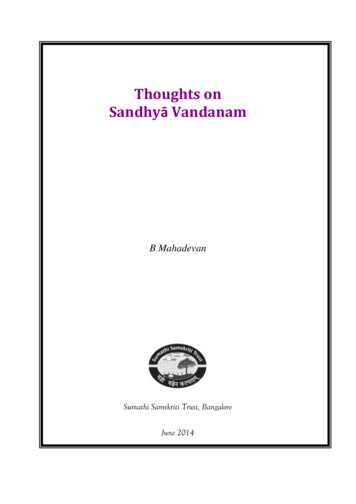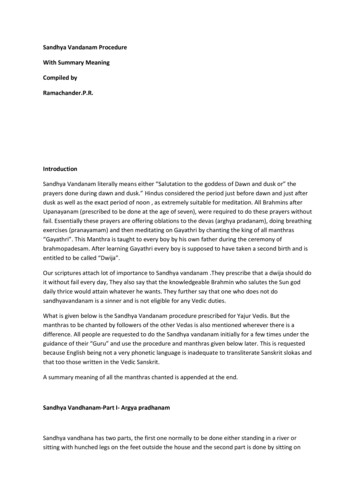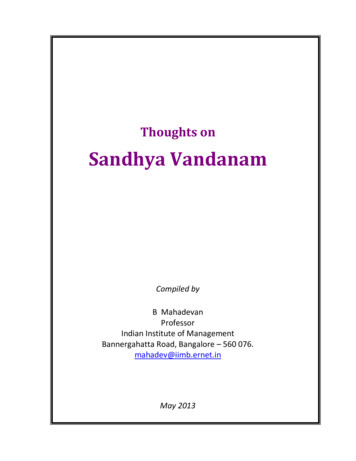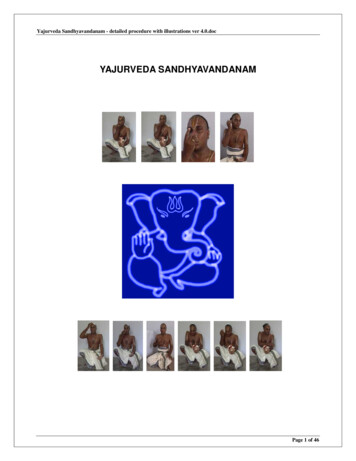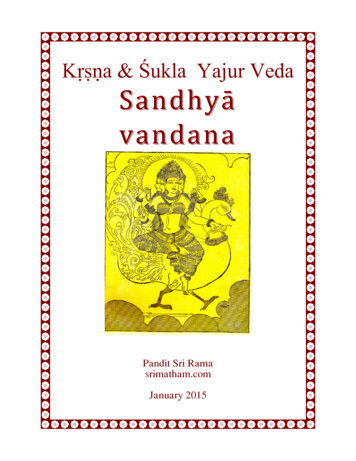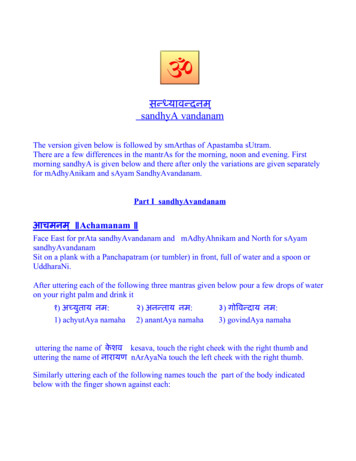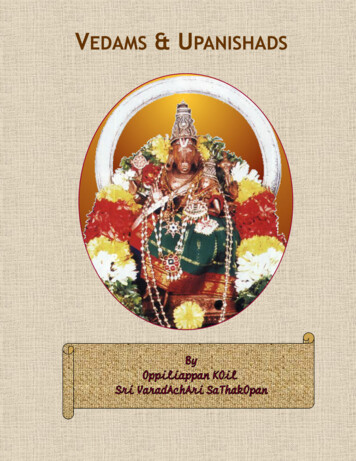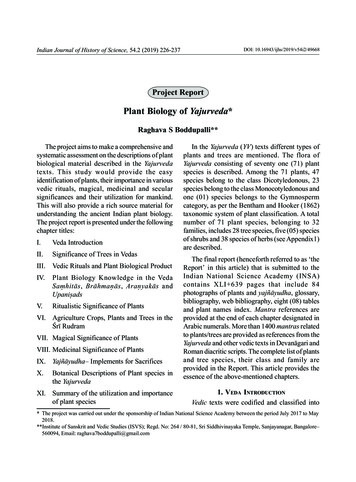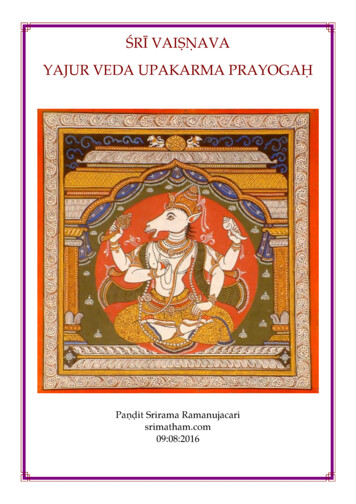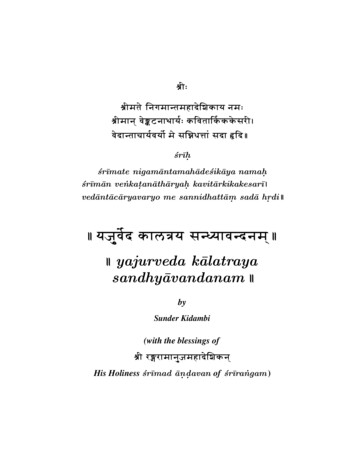
Transcription
(r a;aH(r a;a;ma;tea ;a;na;ga;ma;a;nta;ma;h;a;de ;a;Za;k :a;ya na;maH(r a;a;ma;a;n,a :vea;ñÍ*: .öÐÅ f;na;a;Ta;a;yRaH k :a;va;ta;a;a;kR :k :ke :sa: a Á:vea;d;a;nta;a;.ca;a;yRa;va;ya;eRa mea .sa;a; a;Da: a;Ma .sa;d;a & .a;d Á Áśrı̄h.śrı̄mate nigamāntamahādeśikāya namah.śrı̄mān veṅkat.anāthāryah. kavitārkikakesarı̄ Ávedāntācāryavaryo me sannidhattām. sadā hr. di Á ÁÁ Á ya: ua;veRa;d k :a;l a;ya .sa;nDya;a;va;nd;na;m,a Á ÁÁ Á yajurveda kālatrayasandhyāvandanam Á ÁbySunder Kidambi(with the blessings of(r a;a . ñÍ*: a;ma;a;nua: a;ma;h;a;de ;a;Za;k :n,açÅÅHis Holiness śrı̄mad ān.d. avan of śrı̄raṅgam )
otidprapattcom
otidprapattcom
otidprapattcom
com;a;va;Sa;ya;sUa;.c a;a(vis.ayasūcı̄)ikx :ta;¼a;ta;a;pRa;Na;m,a (kr. tajñatārpan. am)iiA; a;Ba;mua;Ka;m,a (abhimukham)iii :pra; ta;a;va;na;a (prastāvanā).7.9.13iv :pra;a;taH .sa;nDya;a;va;nd;na;m,a (prātah. sandhyāvandanam)ma;a;Dya;a;a; îå :k .sa;nDya;a;va;nd;na;m,a (mādhyāhnika sandhyāvandanam)otv.vi .sa;a;yMa .sa;nDya;a;va;nd;na;m,a (sāyam. sandhyāvandanam)prapatt.51.83. . . . . . . . . . . . . . . . . . . . . . . . . . . . . . . . . . . 115idvii ga;ea: Ma :pra;va: M . ca (gotram and pravaram)19
otidprapattcom
comÁ Á kx :ta;¼a;ta;a;pRa;Na;m,a Á ÁÁ Á kr. tajñatārpan. am Á Á(Acknowledgements)l .[m a;a;na;a;Ta;sa;ma;a: }Ba;Ma na;a;Ta;ya;a;mua;na;ma;Dya;ma;a;m,a ÁA;sma;d;a;.ca;a;yRa;pa;yRa;nta;Ma va;nde gua: :pa: M pa: a;m,a Á Áotlaks. mı̄nāthasamārambhām. nāthayāmunamadhyamām Áasmadācāryaparyantām. vande guruparam. parām Á ÁidWith respectful pran. āms to my ācāryas and pūrvācāryas, I wish toplace on record my heartfelt gratitude to all those who helped me in bringingout this book.prapattMy father Sriman Kidambi Sreenivasachar has tirelessly worked to coordinate the efforts in proofreading this document. He has personally visitedeach of the volunteers and handed a copy of this document for proofreading.The volunteers, in turn, have kindly provided me their feedback on the contents and presentation of this document. From time to time he collected theupdates from them to make sure that the proofreading is done in a stipulatedamount of time. He has spent several hours organizing the comments from thevolunteers to present them to me in a concise form over the telephone. To myfather, I am deeply indebted for the interest and help he has rendered in my endeavor to bring out this book on the occasion of the upanayanam of my sonsChi. Mukund Kidambi and Chi. Sriram Kidambi.I would like to express my sincere thanks to my brother SrimanRaghavan Kidambi, my sister-in-law Srimati Mythili Raghavan and my nephewChi. Mohan Kidambi who have worked with the publishers to get this document printed. They have also been instrumental in requesting the gracefulpresence of His Holiness Śrı̄ Raṅgapriya Mahādeśikan by arranging aanugraha bhās.an. am by Him on the occasion of the upanayanam. Mo-
kx :ta;¼a;ta;a;pRa;Na;m,akr. tajñatārpan. amcomhan has designed the cover page for this book and I wish to sincerely thank himfor his time and effort.My sincere thanks to Sriman H.R. Krishnaswamy who has tirelessly andmeticulously gone through the document to point out mistakes that are difficultto find with a casual reading. I would like to express my gratitude to Sriman Dr.Kidambi Rajagopalan, my uncle, who has provided feedback and suggestionsto improve the presentation of this document. I would also like to recognize andthank the efforts of Sriman C.S. Gopalachar and Sriman Dr. C.R. Ramaswamywho have provided some insightful suggestions.idotNo amount of thanks is enough to express my gratitude to Dr. ParthasarathyDesikan for the help he has rendered. While he has proofread this documentand given suggestions to improve it, I would like to place on record my verysincere and heartfelt thanks for all the help he has rendered so far in terms ofproofreading various documents on our website http://www.prapatti.com. Hehas never hesitated in rendering his help whenever I have asked.prapattI would like to offer my sincere thanks to Sriman R. Rajagopal of Aravind Laboratories, Chennai, popularly known as RR Mama, for requestingthe Śrı̄mukham from His Holiness Śrı̄ Raṅgarāmānujamahādeśikanon my behalf. I also thank him for scanning the Śrı̄mukham and sending itto me by electronic mail.Last, but not the least, my heartfelt thanks to my older son Chi. MukundKidambi for all the help with the photographs in this document and my wifeSmt. Rama Kidambi for making all this happen.Sunder Kidambi8www.prapatti.com
comÁ Á A; a;Ba;mua;Ka;m,a Á ÁÁ Á abhimukham Á Á(Foreword)otGod is the absolute reality endowed with all auspicious and excellentattributes. He is the inner controller of all cit (beings) and acit (matter). Thejı̄vātman enters the physical body appropriate to its past karma (actions)and transmigrates in the cycle of births and deaths (sam. sāra). God, out ofcompassion for the souls, bestows vedic knowledge through brahma and alineage of saints and sages. The vedas discuss the nature of God, nature ofsouls, causes of sam. sāra and ways to get out of it.prapattidVedas prescribe several duties for individual souls to come out of thissam. sāra. They are classified as nitya karmās, or daily duties, and naimittika karmās, or occasional duties. The much extoled sandhyāvandanacomes under nitya karma, or daily duties. We have ample references regarding sandhyāvandana in vedas, smr. tis, rāmāyan. a, mahābhārata andvis. n. u purān. a. The reference to sandhyāvandana in kr. s. n. a yajurvedais as followso! .dùÅ;a;nt a;ma; tM!a;ya;nt a;ma;a;a;d! ;tya;m a; a;Ba;Dya;!a;ya;nku! :vRa;nb.ra; a; !;Na;ea ;a;v!a;dõ;a;nTs!a;k :lM B!a;dÒ m a:(îéau;te!a-Y;sa;a;va; a;a;d! ;tya;ea b.r!a; e ;a;t!a b.ra; E! ;va .sa;nb.ra; ;!a;pyea;a;t!a ya O;!;vMa :vea;d Á Áıııııudyantamastamāhma. yantamādityamabhidhyāyankurvanbrııı′n. bhadramaśnute sāvādityo brahmeti brah. o vidvānthsakalamımaiva sanbrahmāpyeti ya evam. veda Á ÁThe procedure of worship ordained here is by offering arghya at the timeof sunrise and sunset while meditating on āditya (sun god) and chantinggāyatrı̄.Aditya represents pure satva characteristics and it is He who looks afterthe health of the entire world. The individual soul is enveloped with rajo gun.aand tamo gun. a. These adverse vices can be wiped out by offering arghyato the Almighty God in the form of sun and meditating on gāyatrı̄.
A; a;Ba;mua;Ka;m,aabhimukhamcomWorship through arghya is a process by which āditya within us can beinvoked and whose qualities can be acquired. Vedas declare that āditya in thesky and the āditya within our body is one and the same. The vedic statementruns like this.sa ya O;!;Sa;e a .Y;nta;&R .d;ya A;a;k :!a;ZaH Áııısa ya es.o ′ntarh.rdaya ākāśah. Á.sa ya;(ãaÉ ; a;yMa :pua! : :Sea Á ya;(ãÉa;a;sa; a;va;a;a;d! ;tyea Á .sa O;;k ;H ÁıııeÁyaścāsāvādityeÁ sa ekahsa yaścāyampurus. Á.otTherefore, offering arghya definitely has the effect on one who offers it.Taittirı̄yopanis.ad also saysm!a;nde ;h;a.Y: :Nea dõ ;!a;pea :pra; a;[ a;pa;a;nt!/ / a ya;tpr a;d; a;[!a;NMa · · ·ıııidmandehā ′run. e dvı̄pe praks.ıpanti yatpradaks.in. am. ···The meaning is that the arghya offered from the palms of the worshipperdestroys demons known as mantehās attacking the sun. This statement in theveda has a great significance.prapattVedas are referred to as trayı̄, that is, vedic statements have three meanings, namely, external, internal and philosophical. Among them, the philosophical meaning is important. The element of sun in our body is clouded by ourrajo gun. a and tamo gun. a. The arghya offered at the feet of āditya at sunrise and sunset will help free the individual soul from the abovementioned evil qualities. The word in the vedic statement mantehās refersto the devils in our body. Iśāvāsya upanis.ad of śukla yajurveda andchāndogya upanis.ad refer to āditya vidyā, that is, sandhyāvandana.The entire process of sandhyāvandana is centered around arghyapradāna and gāyatrı̄ japa. In addition to this, ācamana, mārjana, āsana,prān. āyāma and upasthāna are also important.The gāyatrı̄ mantra is a very powerful one. All vedas extol theefficacy of gāyatrı̄ mantra. There is no vedic yāga in which this greatSunder Kidambi10www.prapatti.com
A; a;Ba;mua;Ka;m,aabhimukhamcommantra is not used. This mantra has the efficacy of destroying all typesof sins and bestows all auspicious things. This definitely protects the chanter.She is the mother of all mantras. The essence of jagatı̄ and tris.t up chandas is included in gāyatrı̄. She is the embodiment of Almighty Himself.Sandhyāvandana includes āditya vidya and gāyatrı̄ japa. Through thisjapa of gāyatrı̄, one can attain liberation. By performing sandhyāvandanaat the stipulated period, one gets brahma sāyujyam. Thus says veda.otAcharya Saṅkara extols the gāyatrı̄ japa in many places. Theguruparamparā, a biographical work of śrı̄vais. n. ava ācāryas, recordsthat ācārya rāmānuja was offering arghya in sandhyāvandana beingsupported by two persons even at the ripe age of 120.prapattidSunder Kidambi, the author of this book, yajurveda kālatrayasandhyāvandanam, is born in the lineage of Śrı̄ Kidāmbi Acān whowas serving Bhagavad Rāmānuja as his cook. The great preceptor of Śrı̄Vedānta Deśika, that is, Atreya Rāmānuja, also belongs to this greatlineage. The illustrious Śrı̄ Arasān. ipālai Venkat.ād. hvari, a 16th centurypoet, who wrote works like Viśvagun. adarśa Campu, Śrı̄ Rāghavayādavı̄yam and Śrı̄ Laks. mı̄sahasram is a beacon in this lineage. SunderKidambi is a blessed person who has written this beautiful handbook onsandhyāvandana that is very informative and contains all important aspectsof sandhyāvandana in detail. For those who desire to obtain the grace ofthe Almighty, performance of sandhyāvandana is essential. In this direction, Sunder Kidambi has rendered yeoman service to devotees who desireto perform sandhyāvandana. Let all auspicious blessings come to SunderKidambi by the grace of Divya Dampatı̄s Śrı̄ Laks. mı̄nārāyan. a.www.prapatti.comTarka Vedānta VidvānDr. M.E. RangacharMay 16, 2007.11Sunder Kidambi
otidprapattcom
com(r a;aH(r a;a;ma;tea . a;ma;a;nua: a;a;ya na;maH(r a;a;ma;tea ;a;na;ga;ma;a;nta;ma;h;a;de ;a;Za;k :a;ya na;maHśrı̄h.śrı̄mate rāmānujāya namah.śrı̄mate nigamāntamahādeśikāya namah.Á Á :pra; ta;a;va;na;a Á ÁÁ Á prastāvanā Á Áot(Introduction).sa;nDya;a;h ;a;na;ea.Y;Zua;a;.ca;a;nRa;tyMa A;na;hR ;ssa;vRa k :mRa;sua Áya;d;nya;t,a ku . :tea k :mRa na ta; ya :P .l .Ba;a;gBa;vea;t,a Á Áidsandhyāhı̄no ′śucirnityam. anarhassarva karmasu Áyadanyat kurute karma na tasya phalabhāgbhavet Á ÁprapattHe who does not perform sandhyāvandanam every day is ever impure and,consequently, unfit to perform any vedic rites. Whatever other rites he mayperform, he will not obtain the fruit thereof.Duties prescribed to individuals in vedas are classified as nitya karmā,or daily duties, and naimittika karmā, or occasional duties. Sandhyāvandanam is a nitya karmā and, hence, has to be performed daily. It is, infact, to be performed at the appropriate times as bhagavadājñā kaiṅkaryam,that is, as a matter of service rendered to God by way of obeying His command.In vis. n. u dharma, Lord vis. n. u says(rua;a;taH .smxa;a;taH ma;mEa;va;a;¼a;a ya; ya;Ma o . l .z, Gya va;tRa;tea ÁA;a;¼a;a;.cCe .d ;a ma;ma dÒ ea;h ;a ma;d,:Ba;#ta;ea;a;pa na ;vEa;SNa;vaH Á Áśrutih. smr. tih. mamaivājñā yasyām. ullaṅghya vartate Áājñācchedı̄ mama drohı̄ madbhaktopi na vais. n. avah. ÁÁ
:pra; ta;a;va;na;aprastāvanācomThe vedas and the treatises thereunder, that is, smr. tis, convey My commands. Whoever violates them, commits treason. Even if he be My devotee,he is by no means a vais. n. ava.Sandhyāvandanam refers to the worship of sun during sandhyā, themeeting point of day and night, and, fore and after noon. The prayer at sunriseis called prātah. sandhyāvandanam, that at noon is called mādhyāhnikasandhyāvandanam, and that at sunset is called sāyam. sandhyāvandanam. Thus, sandhyāvandanam is performed three times in a day.otThe benefits of prātah. sandhyāvandanam are most (or maximum)when performed before sunrise and stars are visible, average when performedbefore sunrise but stars have disappeared, poor after sunrise, as described bythe following verse.ido a;ma;a ta;a: k :ea;pea;ta;a ma;Dya;ma;a lu .pta;ta;a: k :a ÁA;Da;ma;a .sUa;yRa;sa;a;h;ta;a :pra;a;taH .sa;nDya;a ;a: a;Da;a .smxa;ta;a Á Áprapattuttamā tārakopetā madhyamā luptatārakā Áadhamā sūryasahitā prātah. sandhyā tridhā smr. tā Á ÁFor mādhyāhnika sandhyāvandanam, it is best when the sun is rightabove your head at noon, as described byma;Dya;a; îåe ma;Dya;Ba;a; k . a;m,a Ámadhyāhne madhyabhāskarām ÁSimilarly for sāyam. sandhyāvandanam, it is best before sunset, averageafter sunset but before stars appear and poor after stars appear, as described bythe following verse.o a;ma;a .sUa;yRa;sa;a;h;ta;a ma;Dya;ma;a lu .pta;Ba;a; k . a ÁA;Da;ma;a ta;a: k :ea;pea;ta;a .sa;a;yMa .sa;nDya;a ;a: a;Da;a .smxa;ta;a Á Áuttamā sūryasahitā madhyamā luptabhāskarā Áadhamā tārakopetā sāyam. sandhyā tridhā smr. tā Á ÁSunder Kidambi14www.prapatti.com
:pra; ta;a;va;na;aprastāvanāprapattidotcomIdeally, the prātah. sandhyāvandanam should be started before sunrise and concluded at sunrise. Similarly the sāyam. sandhyāvandanamshould be started before sunset and concluded at sunset (local time). Thesetimings are from considerations of maximum benefit. However, it is important to note that benefits will be there even when there are departures andthis has been recognized in the smr. tis
16.05.2007 · Veda nta De sika, that is, Atreya R am anuja, also belongs to this great lineage. The illustrious Sr ı Aras an . ip alai Venkat.ad.hvari, a 16th century poet, who wrote works like Vi svagun.adar sa Campu, Sr ı R aghavay ada -v ıyam and Sr ı Laks .m ısahasram is a beacon in this lineage. Sunder Kidambi is a blessed person who has written this beautiful handbook on .
